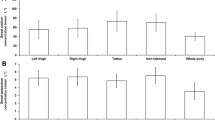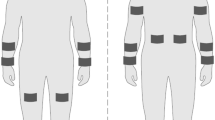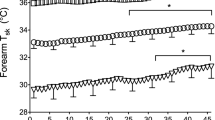Abstract
Purpose
The purpose of the present study was to develop and describe a simple method to evaluate the rate of ion reabsorption of eccrine sweat glands in human using the measurement of galvanic skin conductance (GSC) and local sweating rate (SR). This purpose was investigated by comparing the SR threshold for increasing GSC with following two criteria of sweat ion reabsorption in earlier studies such as (1) the SR threshold for increasing sweat ion was at approximately 0.2–0.5 mg/cm2/min and (2) exercise heat acclimation improved the sweat ion reabsorption ability and would increase the criteria 1.
Methods
Seven healthy non-heat-acclimated male subjects received passive heat treatment both before and after 7 days of cycling in hot conditions (50 % maximum oxygen uptake, 60 min/day, ambient temperature 32 °C, and 50 % relative humidity).
Results
Subjects became partially heat-acclimated, as evidenced by the decreased end-exercise heart rate (p < 0.01), rate of perceived exhaustion (p < 0.01), and oesophageal temperature (p = 0.07), without alterations in whole-body sweat loss, from the first to the last day of training. As hypothesized, we confirmed that the SR threshold for increasing GSC was near the predicted SR during passive heating before exercise heat acclimation, and increased significantly after training (0.19 ± 0.09–0.32 ± 0.10 mg/cm2/min, p < 0.05).
Conclusions
The reproducibility of sweat ion reabsorption by the eccrine glands in the present study suggests that the relationship between GSC and SR can serve as a new index for assessing the maximum rate of sweat ion reabsorption of eccrine sweat glands in humans.




Similar content being viewed by others
Abbreviations
- ANOVA:
-
Analysis of variance
- BWR:
-
Body weight reduction
- GSC:
-
Galvanic skin conductance
- HR:
-
Heart rate
- MAP:
-
Mean arterial blood pressure
- NaCl:
-
Sodium chloride
- RPE:
-
Rate of perceived exhaustion
- SR:
-
Sweat rate
- T b :
-
Mean body temperature
- T es :
-
Oesophageal temperature
- \(\overline{T}_{\text{sk}}\) :
-
Mean skin temperature
- \({{\dot{\text{V}}}\text{O}}_{{ 2 {\text{max}}}}\) :
-
Maximum oxygen uptake
References
Allan JR, Wilson CG (1971) Influence of acclimatization on sweat sodium concentration. J Appl Physiol 30(5):708–712
Araki T, Matsushita K, Umeno K, Tsujino A, Toda Y (1981) Effect of physical training on exercise-induced sweating in women. J Appl Physiol Respir Environ Exerc Physiol 51(6):1526–1532
Boisvert P, Candas V (1994) Validity of the Wescor’s sweat conductivity analyzer for the assessment of sweat electrolyte concentrations. Eur J Appl Physiol 69(2):176–178
Borg GA (1982) Psychophysical bases of perceived exertion. Med Sci Sports Exerc 14(5):377–381
Boucsein W, Fowles DC, Grimnes S, Ben-Shakhar G, Roth WT, Dawson ME, Filion DL (2012) Publication recommendations for electrodermal measurements. Psychophysiology 49(8):1017–1034. doi:10.1111/j.1469-8986.2012.01384.x
Bulmer MG, Forwell GD (1956) The concentration of sodium in thermal sweat. J Physiol 132(1):115–122
Buono MJ, Ball KD, Kolkhorst FW (2007) Sodium ion concentration vs. sweat rate relationship in humans. J Appl Physiol 103(3):990–994. doi:10.1152/japplphysiol.00015.2007
Buono MJ, Claros R, Deboer T, Wong J (2008) Na + secretion rate increases proportionally more than the Na + reabsorption rate with increases in sweat rate. J Appl Physiol 105(4):1044–1048. doi:10.1152/japplphysiol.90503.2008
Cheuvront SN, Bearden SE, Kenefick RW, Ely BR, Degroot DW, Sawka MN, Montain SJ (2009) A simple and valid method to determine thermoregulatory sweating threshold and sensitivity. J Appl Physiol 107(1):69–75. doi:10.1152/japplphysiol.00250.2009
Darrow CW (1964) The rationale for treating the change in galvanic skin response as a change in conductance. Psychophysiology 1:31–38
Eichna LW, Park CR, Nelson N, Horvath SM, Palmes ED (1950) Thermal regulation during acclimatization in a hot, dry (desert type) environment. Am J Physiol 163(3):585–597
Fowles DC (1986) The eccrine system and electrodermal activity. In: Coles GH, Donchin E, Porges SW (eds) Psychophysiology: systems, processes, and applications. Guilford Press, New York, pp 51–96
Gerrett N, Redortier B, Voelcker T, Havenith G (2013) A comparison of galvanic skin conductance and skin wettedness as indicators of thermal discomfort during moderate and high metabolic rates. J Therm Bio 38:530–538
Gisolfi CV, Cohen JS (1979) Relationships among training, heat acclimation, and heat tolerance in men and women: the controversy revisited. Med Sci Sports 11(1):56–59
Gutrecht JA (1994) Sympathetic skin response. J Clin Neurophysiol 11(5):519–524
Hamouti N, Del Coso J, Ortega JF, Mora-Rodriguez R (2011) Sweat sodium concentration during exercise in the heat in aerobically trained and untrained humans. Eur J Appl Physiol 111(11):2873–2881. doi:10.1007/s00421-011-1911-6
Hardy JD, DuBois EF (1938) Basal metabolism, radiation, convection and vaporization at temperature of 22 to 35 degree C. J Nutr 15:477–497
Inoue Y, Nakao M, Ishizashi H, Tsujita J, Araki T (1998) Regional differences in the Na + reabsorption of sweat glands. Appl Human Sci 17(5):219–221
Kuno Y (1956) Human perspiration. Charles C. Thomas, Springfield
Machado-Moreira CA, Taylor NA (2012) Psychological sweating from glabrous and nonglabrous skin surfaces under thermoneutral conditions. Psychophysiology 49(3):369–374. doi:10.1111/j.1469-8986.2011.01309.x
Mitchell D, Senay LC, Wyndham CH, van Rensburg AJ, Rogers GG, Strydom NB (1976) Acclimatization in a hot, humid environment: energy exchange, body temperature, and sweating. J Appl Physiol 40(5):768–778
Sato K, Kang WH, Saga K, Sato KT (1989) Biology of sweat glands and their disorders. I. Normal sweat gland function. J Am Acad Dermatol 20(4):537–563
Shamsuddin AK, Kuwahara T, Oue A, Nomura C, Koga S, Inoue Y, Kondo N (2005a) Effect of skin temperature on the ion reabsorption capacity of sweat glands during exercise in humans. Eur J Appl Physiol 94(4):442–447. doi:10.1007/s00421-005-1354-z
Shamsuddin AK, Yanagimoto S, Kuwahara T, Zhang Y, Nomura C, Kondo N (2005b) Changes in the index of sweat ion concentration with increasing sweat during passive heat stress in humans. Eur J Appl Physiol 94(3):292–297. doi:10.1007/s00421-005-1314-7
Stolwijk JA, Hardy JD (1966) Partitional calorimetric studies of responses of man to thermal transients. J Appl Physiol 21(3):967–977
Thomas PE, Korr IM (1957) Relationship between sweat gland activity and electrical resistance of the skin. J Appl Physiol 10(3):505–510
Verde T, Shephard RJ, Corey P, Moore R (1982) Sweat composition in exercise and in heat. J Appl Physiol Respir Environ Exerc Physiol 53(6):1540–1545
Vetrugno R, Liguori R, Cortelli P, Montagna P (2003) Sympathetic skin response: basic mechanisms and clinical applications. Clin Auton Res 13(4):256–270. doi:10.1007/s10286-003-0107-5
Wang GH (1957) The galvanic skin reflex; a review of old and recent works from a physiologic point of view. Am J Phys Med 36(5):295–320
Wyndham CH, Rogers GG, Senay LC, Mitchell D (1976) Acclimization in a hot, humid environment: cardiovascular adjustments. J Appl Physiol 40(5):779–785
Acknowledgments
We would like to thank our volunteer subjects for participating in this study. NK is supported by Grants-in-Aid for Scientific Research (No. 23300231) from the Japan Society for the Promotion of Science (JSPS) from the Ministry of Education, Culture, Sports, Science and Technology of Japan. TA is supported by a JSPS fellowship (No. 244185) from the Ministry of Education, Culture, Sports, Science and Technology of Japan. TN is supported by a Grant-in-Aid for Scientific Research (no. 25242061) from the Japan Society for the Promotion of Science (JSPS) from the Ministry of Education, Culture, Sports, Science and Technology of Japan.
Author information
Authors and Affiliations
Corresponding author
Ethics declarations
Conflict of interest
None.
Additional information
Communicated by Guido Ferretti.
Rights and permissions
About this article
Cite this article
Amano, T., Gerrett, N., Inoue, Y. et al. Determination of the maximum rate of eccrine sweat glands’ ion reabsorption using the galvanic skin conductance to local sweat rate relationship. Eur J Appl Physiol 116, 281–290 (2016). https://doi.org/10.1007/s00421-015-3275-9
Received:
Accepted:
Published:
Issue Date:
DOI: https://doi.org/10.1007/s00421-015-3275-9




